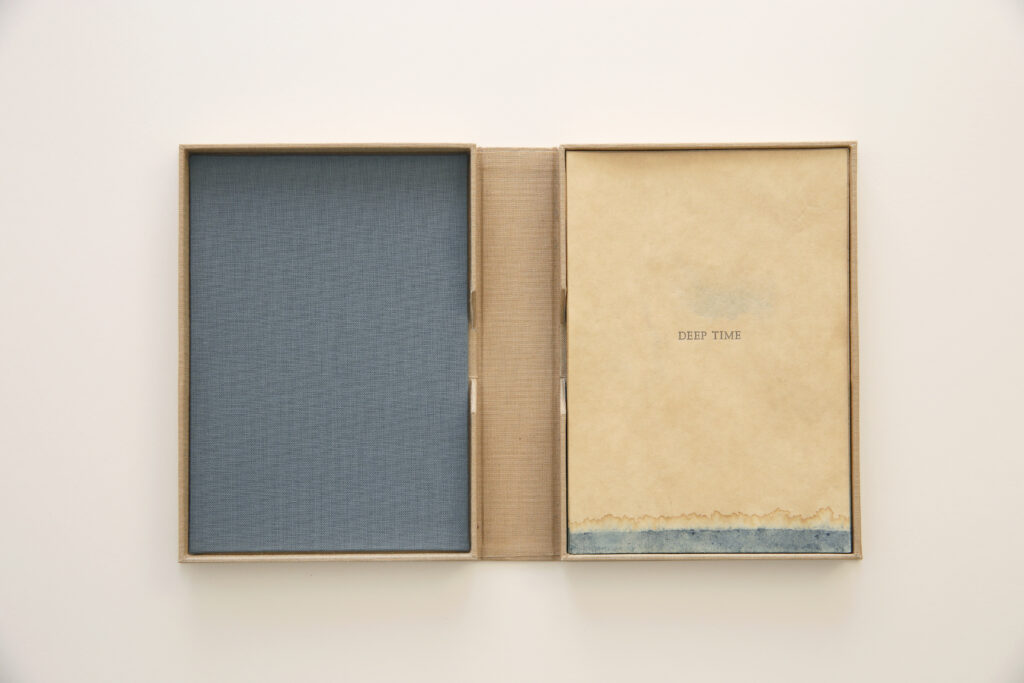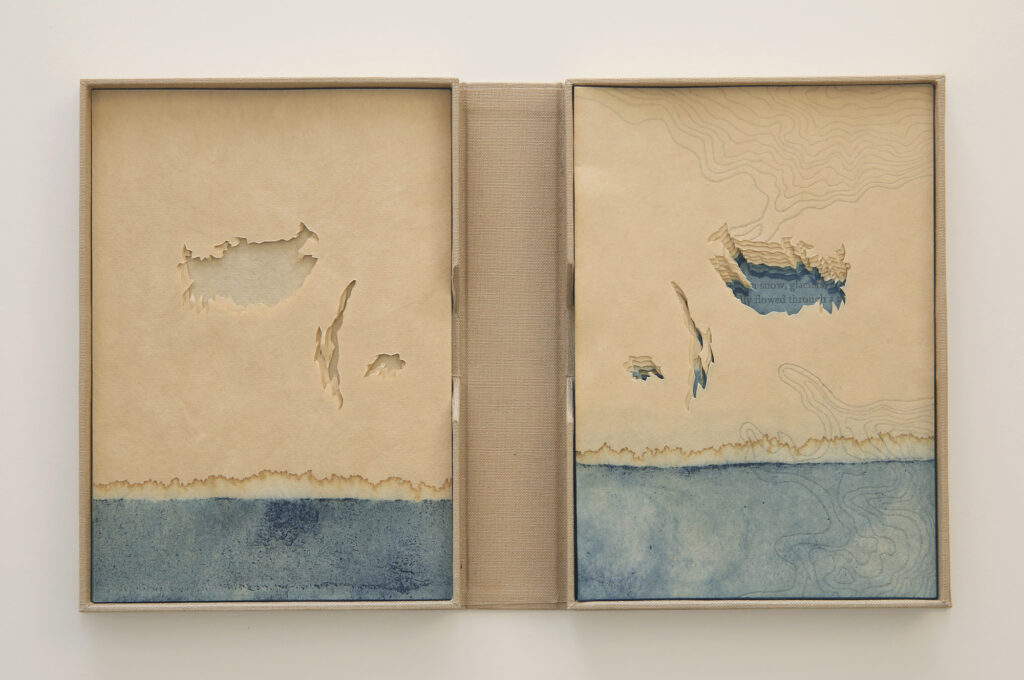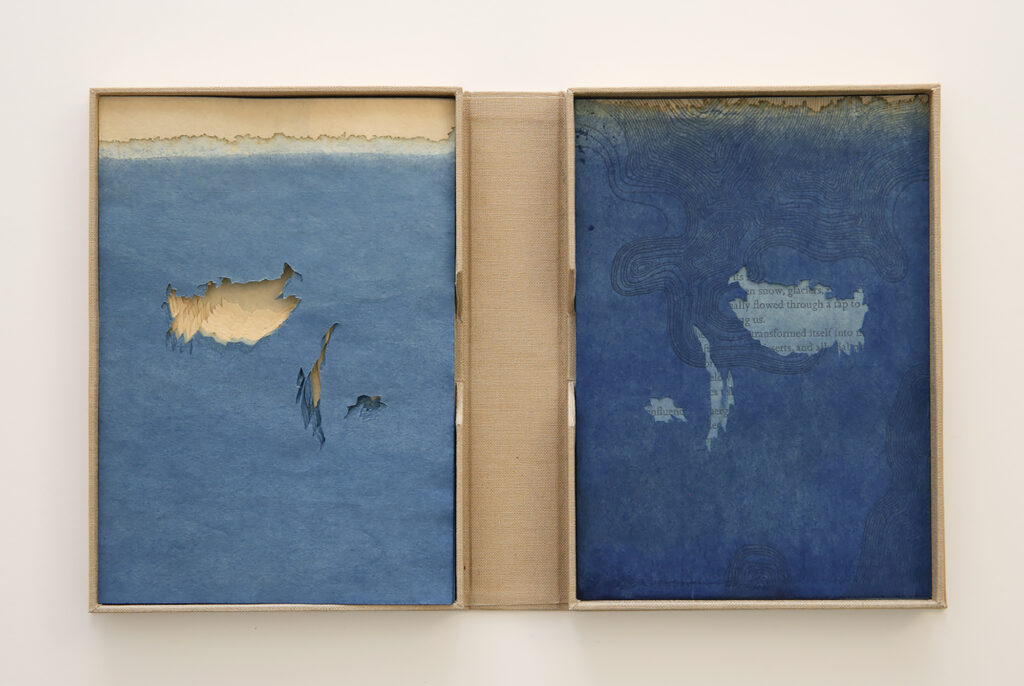
Radha Pandey
Self-published, 2017.
6 x 4.25 inches (closed) 19 unbound stacked leaves. Edition of 35.
Printed on Kozo paper dyed with cloves, indigo; imagery created from hand-engraved wood blocks by the artist. Unbound leaves laid in tan cloth clamshell case lined with blue cloth. Letterpress printed.
To experience book-artist and papermaker Radha Pandey’s Deep Time is to be quietly overcome: by the book’s structure, the artist’s technique, and the work’s concept. Presented in a clamshell box, Deep Time consists of a series of 19 4 x 6 inch unbound sheets, each dyed with indigo at the bottom to represent water and cloves at the top to represent soil. Moving through the work, one understands there is a transition in play, that these colors speak somehow of nature and our place in it. Each page also has a series of cut-outs representing the three highest physical boundaries on Earth’s surface: the Tibetan Plateau, the Andes mountain range, and the Kanza’gyal mountain range. As the pages are turned and stacked inside the opposite side of the clamshell box, the cut-outs deepen, building or receding as the reader progresses through the book. As unbound pages, the reader reenacts the process of erosion and sedimentation at their own pace, emphasizing the concept of the work. The final page of Deep Time includes an explanation of both the fragile balance and enormous debt humankind owes to soil and water, emphasizing the importance of our relationship with the planet.

The book is an eloquent visual representation of Scottish geologist James Hutton’s concept of deep time. First proposed in 1788, Hutton suggested that Earth’s geological features (such as mountain ranges) were formed by cycles of sedimentation and erosion. He introduced a process of systematically measuring time to track Earth’s changes while quantifying time in such a way that humankind could comprehend the idea of its evolution over millions of years.

Deep Time was created using techniques that call to mind the processes of erosion and sedimentation: making and dyeing the paper by hand (sedimentation) and hand carving the maple printing blocks (erosion). The use of hand-dyeing with indigo and clove creates a sophisticated palette in perfect harmony with the work’s primary focus on nature; this aspect was carefully reproduced when editioning the work. Dipping Kozo page sets into clove and indigo dye created strong horizontal compositions where the two colors meet and push against each other. In turn, this becomes a visual representation of the ridges and ranges which the work seeks to highlight. These techniques also represent a sort of sedimentation of the artist’s mind, a sifting, processing, and refining that eventually creates a thing of beauty (much like the mountain ranges depicted in the book). As Pandey states, “Just as nature takes its time to evolve, slowly and thoughtfully, I make, at a slow and deliberate pace, work that evokes that very meaning.”[1] It’s an elegant exploration of humankind’s relationship to our planet.

These methods were immensely time consuming for the artist and editioning process. “Each sheet was progressively held down longer and longer to get a stronger blue,” Pandey explains. “As the indigo soaked into the sheet, it pushed the clove up, and created the beautiful ridge I was after for this project.”[2] Deep Time also incorporates letterpress imagery reminiscent of topographic maps, the lines contributing to the feel of ebb and flow throughout the book, embodying the deep time of its own making: a gestation, a distillation, and a layering process which plays out over months (and sometimes years) as the book is editioned. Throughout the work, these layers are crucial. The visual ebb and flow, reader-created pacing, and single sheets versus a traditional bound codex, effectively connect the concept and process of Deep Time.

In viewing Pandey’s entire body of work, it is evident that her passion lies with subjects related to humankind’s relationship with Earth’s natural resources. Memory of Long Ago (2018) explores the essence of the color white, while Algal/Fungal (2018) presents readers with an overview of the organism lichen. But Pandey’s dedication to her subject matter is most effective in Deep Time. Each aspect of the work — structure, materials, concept — is layered and carefully overlaps, much like the geological phenomena she references. Within the pages of Deep Time, a reader can effectively hold a mountain range in the palm of their hand, and in turn, grasp the enormity of what that means.The final pages of Deep Time consist of a colophon succinctly outlining Pandey’s reflections on the nature of our relationship to water and soil. Readers are encouraged to consider not only their consumption and use of the planet’s natural resources, but how to better take care of those resources. By withholding any sort of contextual narrative until the conclusion of the work, Pandey provides an opportunity for readers to develop their own questions and narrative around the abstract and tactile pages. Extending an invitation to the reader, Pandey encourages us to reflect on the Earth’s constant change and the passing of geological time.
- (1)
“Artist Statement,” https://www.radhapandey.com/about (accessed 09.03.21)
- (2)
ibid

Radha Pandey
Self-published, 2017.
6 x 4.25 inches (closed) 19 unbound stacked leaves. Edition of 35.
Printed on Kozo paper dyed with cloves, indigo; imagery created from hand-engraved wood blocks by the artist. Unbound leaves laid in tan cloth clamshell case lined with blue cloth. Letterpress printed.



